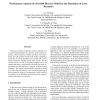Free Online Productivity Tools
i2Speak
i2Symbol
i2OCR
iTex2Img
iWeb2Print
iWeb2Shot
i2Type
iPdf2Split
iPdf2Merge
i2Bopomofo
i2Arabic
i2Style
i2Image
i2PDF
iLatex2Rtf
Sci2ools
95
Voted
ICPPW
2006
IEEE
2006
IEEE
Performance Analysis of a Parallel Discrete Model for the Simulation of Laser Dynamics
This paper presents an analysis on the performance of a parallel implementation of a discrete model of laser dynamics, which is based on cellular automata. The performance of a 2D parallel version of the model is studied as a first step to test the feasibility of a parallel 3D version, which is needed to simulate specific laser systems. The 3D version will have to run on a parallel computer due to its runtime and memory requirements. The model has been implemented on a Beowulf Cluster using the message passing paradigm. The parallel implementation is found to exhibit a good speedup, allowing us to run realistic simulations of laser systems on clusters of workstations, which could not be afforded on an individual machine due to the extensive runtime and memory size needed.
2D Parallel Version | Distributed And Parallel Computing | ICPPW 2006 | Parallel 3D Version | Parallel Implementation |
Related Content
| Added | 11 Jun 2010 |
| Updated | 11 Jun 2010 |
| Type | Conference |
| Year | 2006 |
| Where | ICPPW |
| Authors | Jose Luis Guisado, Francisco Fernández de Vega, K. A. Iskra |
Comments (0)

